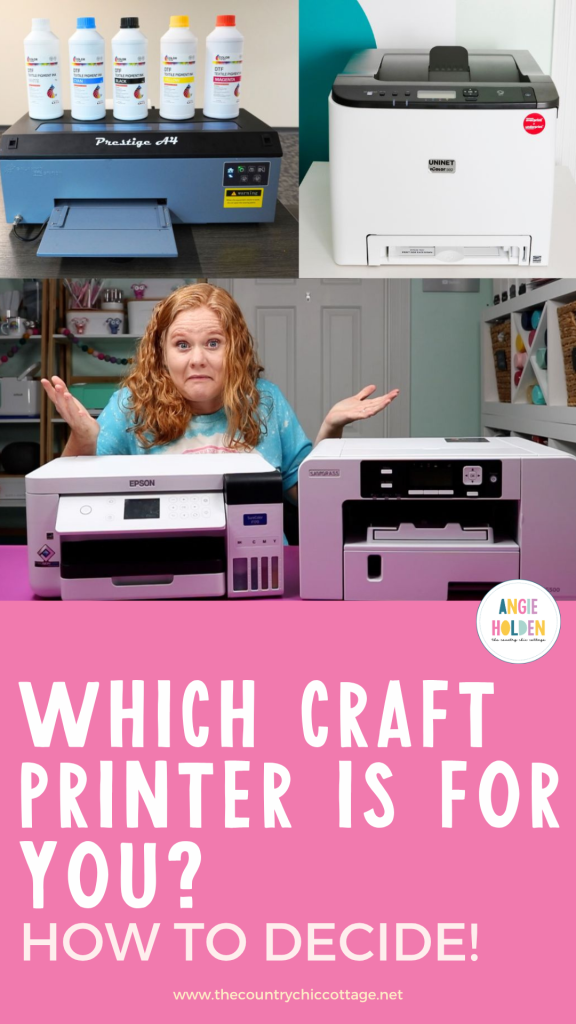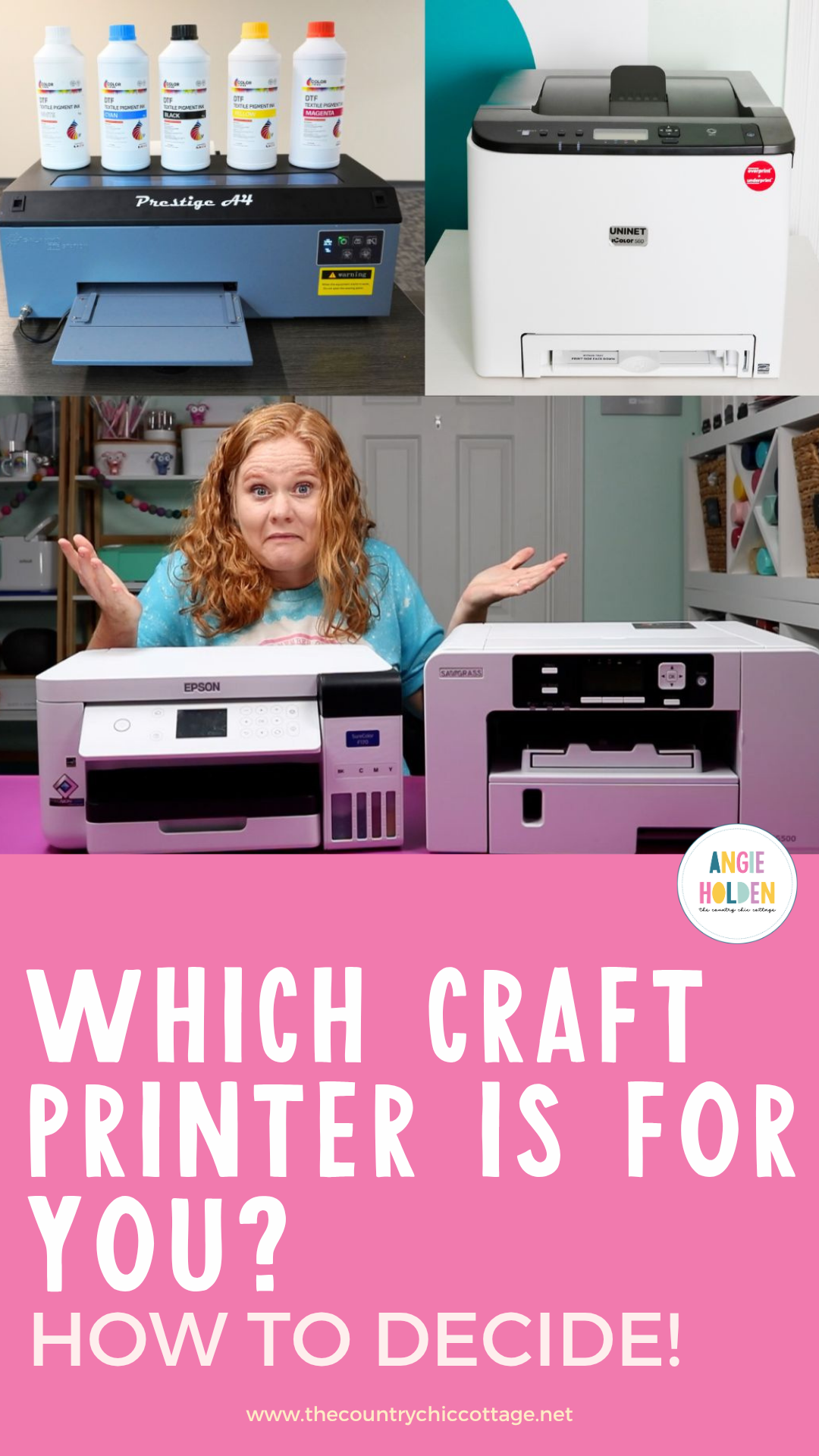Over the past few years, new craft printers have been emerging regularly, and which one you may need for the projects you want to make can get confusing.
I'm going to run through several printer options to help you decide which ones you need for the crafts you want to make and which ones you can wait on.
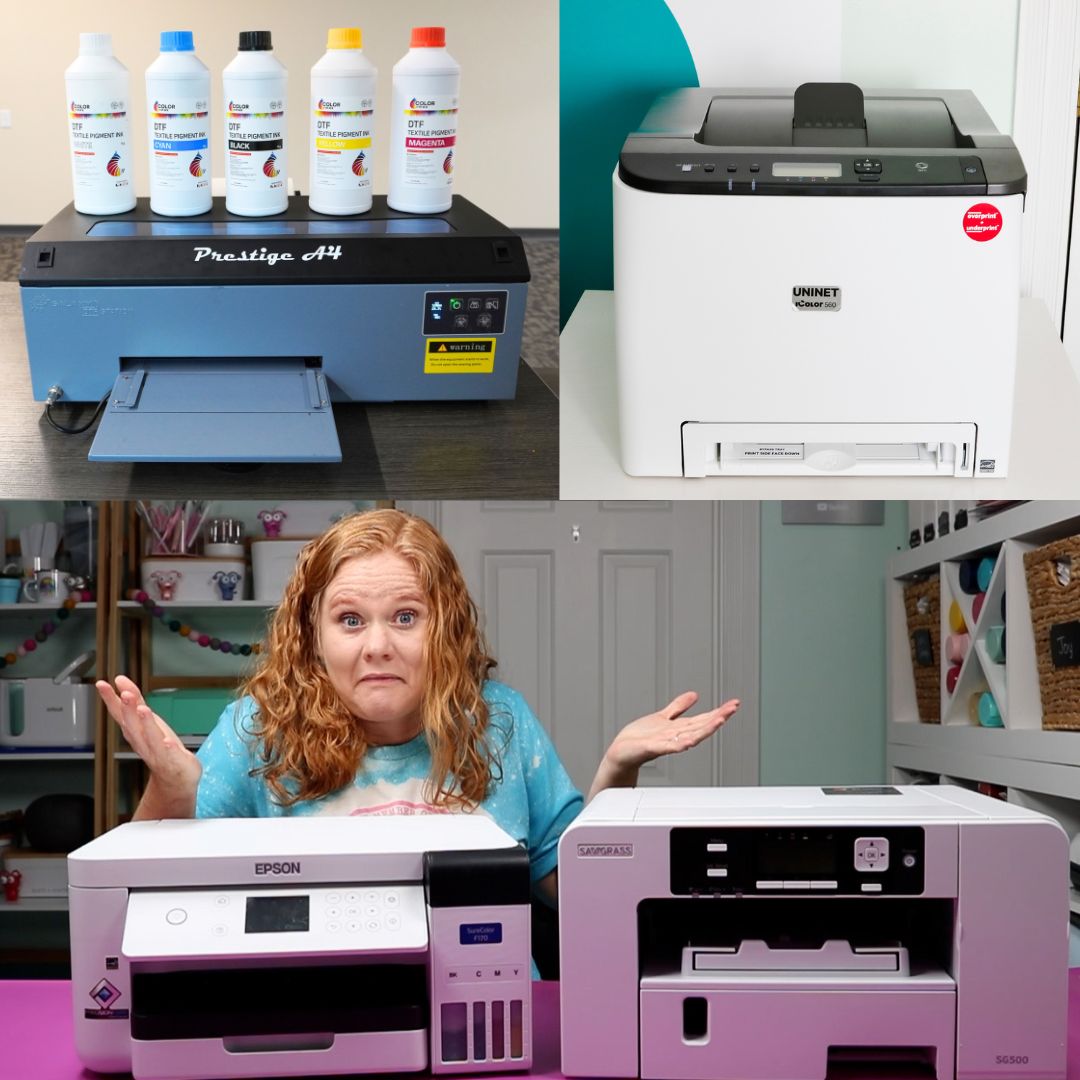
Because there is always something new coming out, it's unlikely I am going to touch on every craft printer you've ever heard of today. If you have a craft printer you'd like to learn more about that I don't cover, make sure to drop down in the comments and tell me about it so I can look into it.
You can watch me walk through these different printers today by pressing play on the video below.
Craft Printers
For each of the different printer types, I am going to talk about who needs one, what types are on the market, and what types of projects you can make with them.
If there are specific features I think you should consider, I will mention those as well.
Home Printer
First, we're going to talk about home printers. This is a printer you may already have in your home, even if you don't use it for crafting.
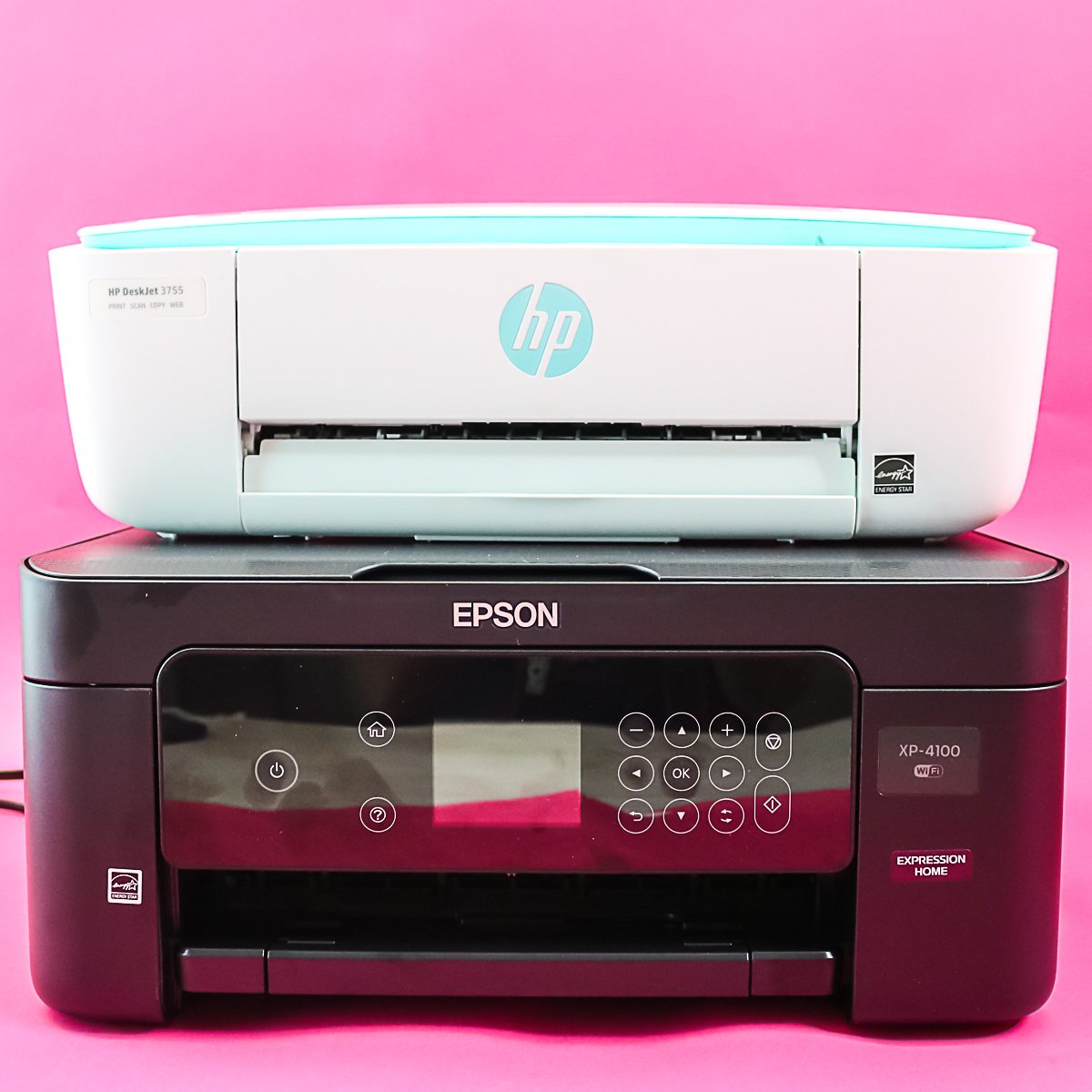
Different Home Printer Types
When it comes to a home printer, you may have an inkjet or laser printer. These printers are the ones you may use to print out school work, photos, and other documents. These printers use regular ink or toner, and your designs should look how you want them to when they come out of the printer.
What Projects Can You Make with a Home Printer?
There are a lot of projects you can make using your home printer. You can make stickers, iron-on transfers, and other Print Then Cut projects.
There are a lot of different materials on the market that you can use with your home printer, including but not limited to:
- Stickers (waterproof, planner, and more)
- Temporary Tattoos
- Siser DTV
- Iron-on transfers
- Labels
If you're looking at creating these projects with your home printer, you'll want to make sure of a few things.
- Make sure the materials you're using are for the printer type you have. Laser and Inkjet printers do require materials specifically made for them.
- Check the print quality before you begin. Make sure you can get the quality you want for your design before you waste more expensive materials. Some printers print documents well, but don't perform well for photos. Test your settings and make sure you can get a good print.
- If you're using thicker materials like printable sticker paper, cardstock, iron-on transfers, and even some photo papers, you will want a printer that has a rear feed, and you'll want to confirm it can print thicker papers. There is nothing more frustrating than dealing with paper jams that ruin your materials.
Who Needs a Home Printer?
Honestly, I think everyone should have a home printer. It's a great place to start, and even with all the other printers I own, I still use my home printer for projects like planner stickers, party decor, and even some iron-on transfers.
You do need to be aware that projects made with a home printer may not last as long as projects made with other materials.
Stickers made with a home printer won't last as long as a UV DTF sticker. Printable iron-on transfers may fade or lift more quickly than more advanced printing technology. If you want to get started to see if these types of crafts are for you, this is a great place to start.
Sublimation Printers
The next printer we're going to talk about is a sublimation printer. These seem to be the natural progression for people who use a home printer when crafting.
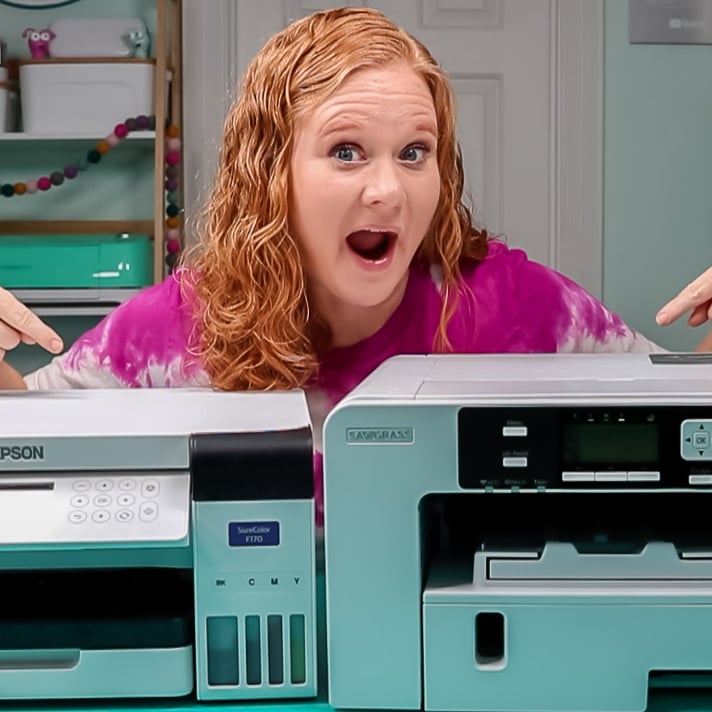
Different Types of Sublimation Printers
While there are a variety of different sublimation printer brands, there are basically two types of sublimation printers. You have a traditional sublimation printer and a converted sublimation printer.
In order to do sublimation, you have to have sublimation ink. A traditional sublimation printer will come with sublimation ink and is created specifically for that ink. Sublimation ink is a little thicker than traditional ink, which requires more regular printing to keep the lines from clogging.
With a traditional sublimation printer, many options do their own maintenance, so even if you can't print regularly, as long as it's plugged in and on, it will keep the ink flowing, so you don't have to worry about clogs.
A converted sublimation printer is a regular home printer, usually an Epson EcoTank, that has sublimation ink added to it. These can work, and I know many people who use these without problems, but the printer is not made for this type of ink.
That means you're more likely to run into clogging issues. These printers don't run their own maintenance, which means you need to be printing regularly, at least once a week if not more. You may also run into color issues with your prints.
Traditional sublimation printers will be more expensive than a converted sublimation printer, and the ink is typically more expensive as well. The headaches you get from working with a converted sublimation printer, however, may make that price worth it over time.
What Projects Can You Make with a Sublimation Printer?
I think a better question is what projects can't you make with a sublimation printer?
When sublimation first started exploding in the crafting world, there weren't a lot of blanks readily available for the home crafter. That is no longer the case. Now, I can't think of a project I've thought of that I couldn't find a sublimation-compatible blank for it.
There are limits, though. Your blank needs to be white or light in color, and it needs to either have a high polyester count or have a poly coating.
Sublimation can be added to hard and soft surfaces, and at this point, the list is endless:
- Shirts, socks, ties, aprons, and other clothing items
- Towels
- Bookmarks
- Keychains
- Mugs
- Tumblers
- Clocks
- Nightlights
- Cutting Boards
- Wood Blanks
- Bibs
- Hairbows
- Blankets
- Fingernails
- Phone cases
- Pens
- Pencils
- Straws
As you can see, there are so many things you can make with sublimation, that list isn't even close to everything.
Who Needs a Sublimation Printer?
If you're interested in full-color designs that will last at least as long as the surface you add it to, you'll want to look into sublimation.
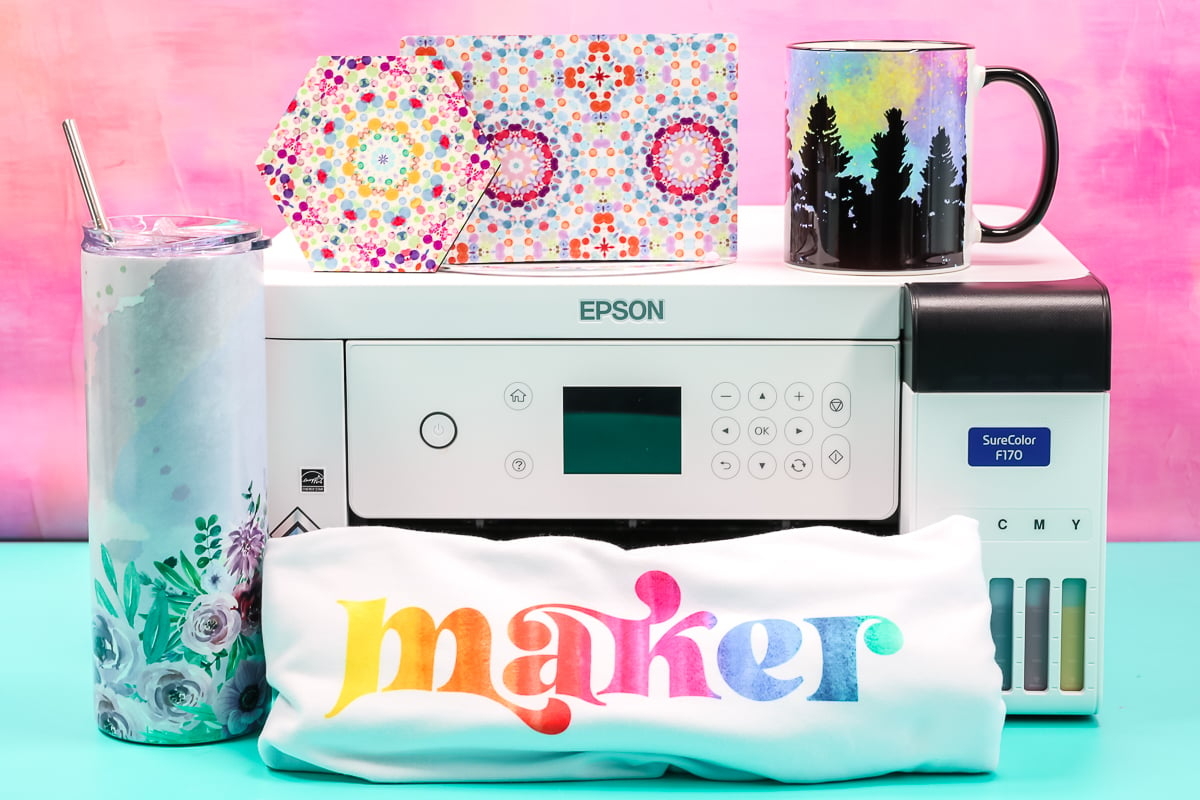
I don't know that there is another crafting process that lasts as long as sublimation prints last. Because the ink actually infuses into the blank, you cannot feel it, and it will never scratch off.
Learn more about sublimation printers in my sublimation printer comparison video.
Where Does the Sawgrass VersiFlex Fit In?
There is a new ink and paper system on the market called VersiFlex. This ink system allows you to print sublimation prints that can be used just like a traditional sublimation print.
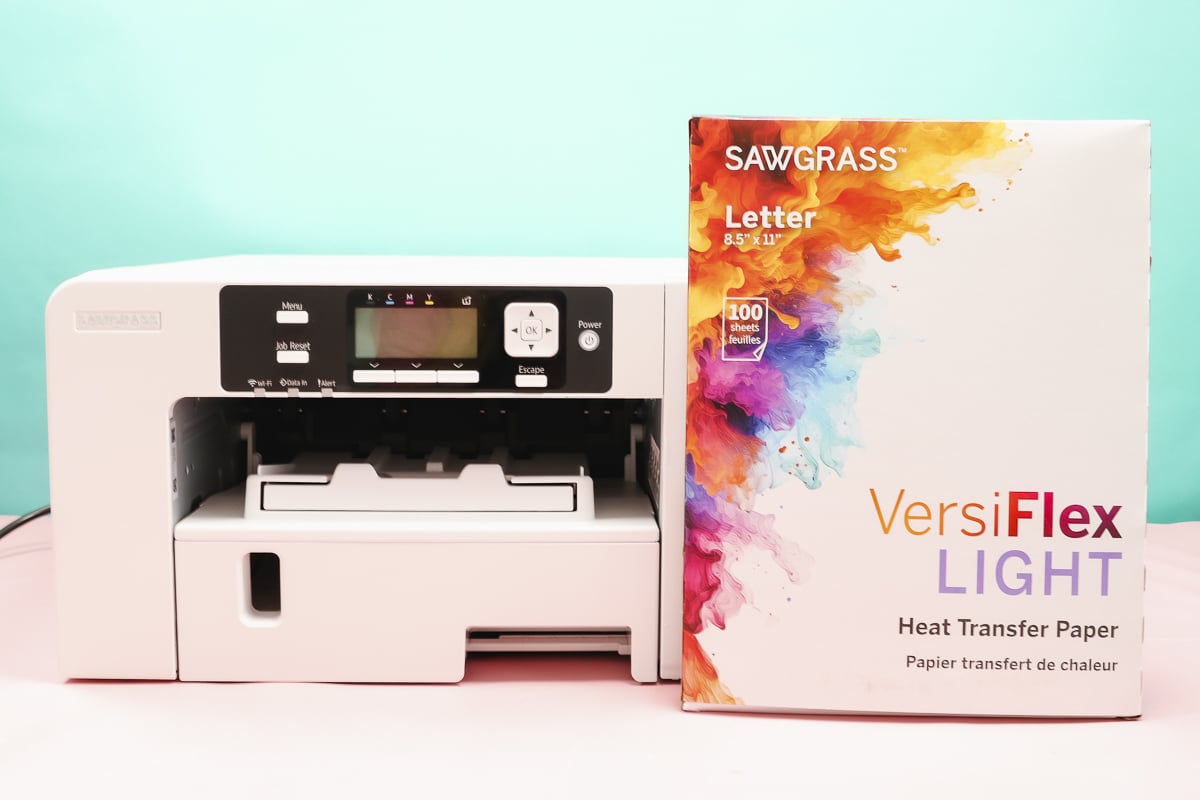
It also has a special paper that you can use with the ink that allows you to put full color designs on cotton blanks. Blanks still need to be light in color, and to be honest, I am not the biggest fan of the whole system.
You can learn all about it in my full video review and tutorial.
Note: As we move into the following printers, there is a significant price increase compared to home printers and sublimation printers.
DTF Printers
DTF stands for Direct to Film and gives you the ability to print on any color fabric, and you can press on cotton, cotton poly blends, and more.
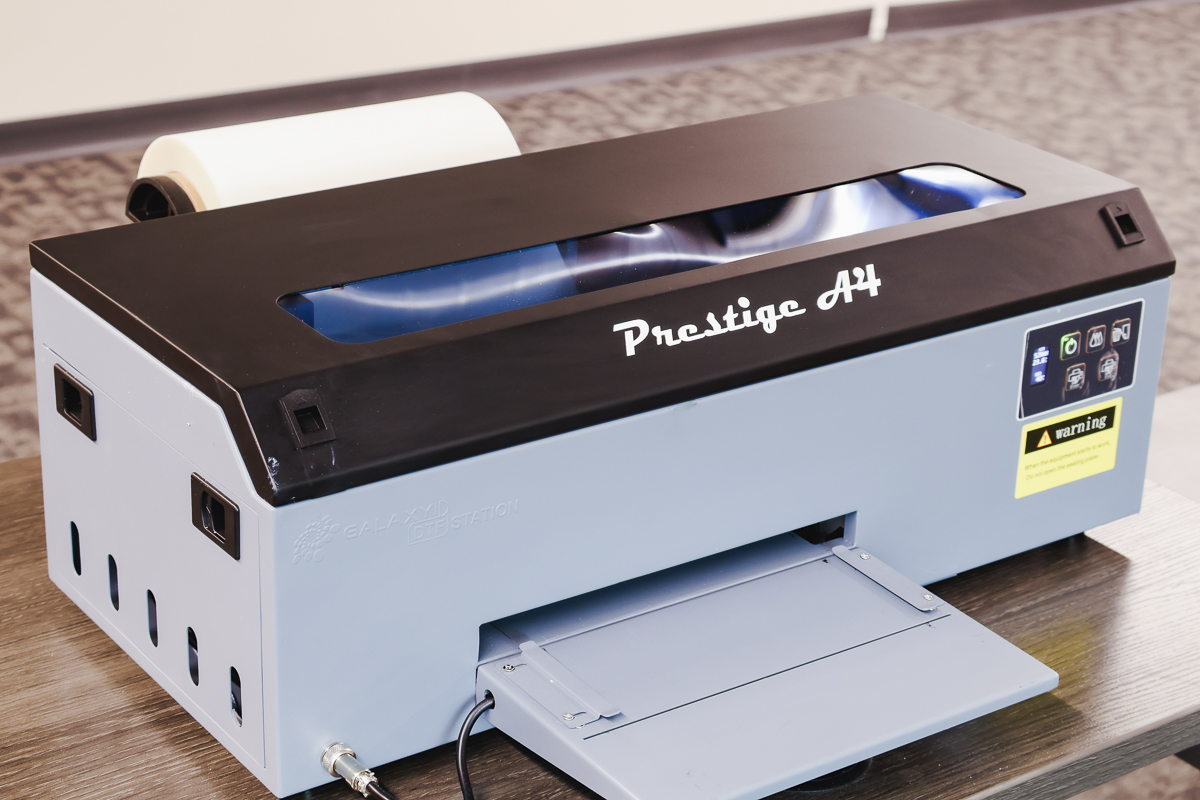
Different Types of DTF Printers
When it comes to DTF printing, you need more than just the printer. You will also need the adhesive powder system and a dryer.
I only recommend the whole DTF printing system. There are hacks out there that people use, but I have safety concerns about those hacks and really DTF printing as a whole.
If you want to get into DTF printing, make sure you know how the printer works and how to use it safely. I have a full review of DTF printers. I recommend starting there.
What Projects Can You Make with DTF Printers?
With DTF prints, you can make projects that use fabric blanks or porous surfaces. DTF prints do not work on hard surfaces.
When it comes to projects, though, the options are endless:
- Shirts
- Aprons
- Hats
- Linen/Fabric Notebooks
- Paper Banners
I've tested these different materials and had success with all of them.
Who Needs a DTF Printer?
I think the people who need to own a DTF printer are definitely business owners. DTF printers require regular use and daily maintenance. They are prone to clogging, so they can't sit for any length of time.
I have safety concerns because of the particles from the adhesive, and I do not recommend the DTF hack that some people are doing.
I do think DTF is a great method for your projects, and I highly recommend ordering prints if you're not ready for the whole printing process.
Pressing DTF prints could not be easier. I love the process, and the finished results are amazing.
White Toner Printers
Another form of craft printer that is similar to DTF is white toner printing. Like DTF, these prints can be added to any color blank, and you don't need a special coating on the blank.
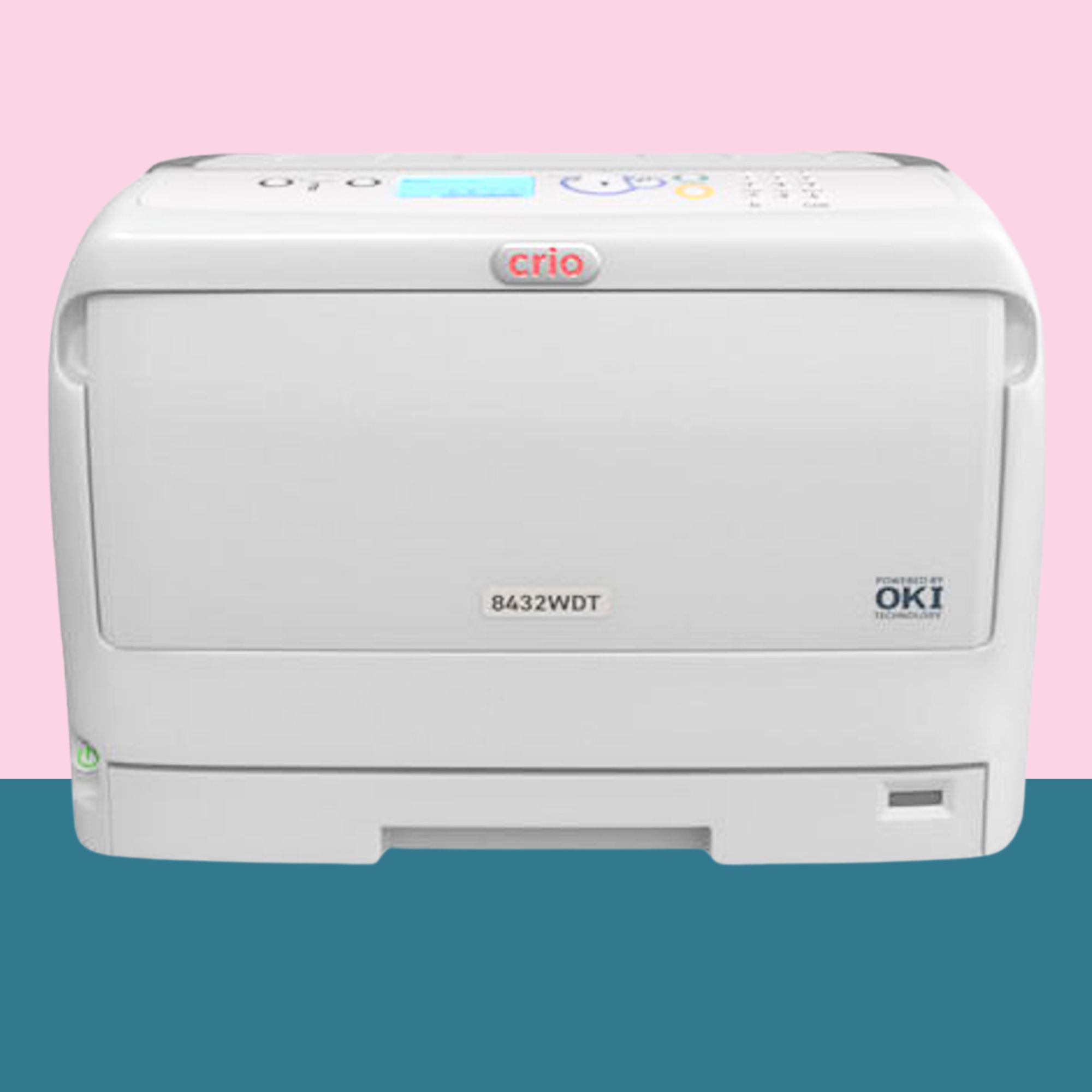
Different Types of White Toner Printers
There are a lot of different white toner printers on the market, and like DTF, I recommend purchasing the printer through a reputable seller. These printers are expensive, and you'll want a company that will back you up and help you with learning how to use the machine.
I recommend both the Crio and iColor white toner printers. I own both and have full reviews that you can watch to learn more about both of them.
The iColor white toner printer has the ability to add sublimation cartridges, so it can be used as a white toner printer, sublimation printer, and a regular everyday printer.
Unlike DTF, I have no safety concerns with white toner printers. There is also no maintenance required. You can use the printer daily or every couple of months, and it will work perfectly every time.
What Projects Can You Make with a White Toner Printer?
You can make almost anything with a white toner printer. Depending on the film and adhesive you use, you can add prints to hard and soft surfaces.
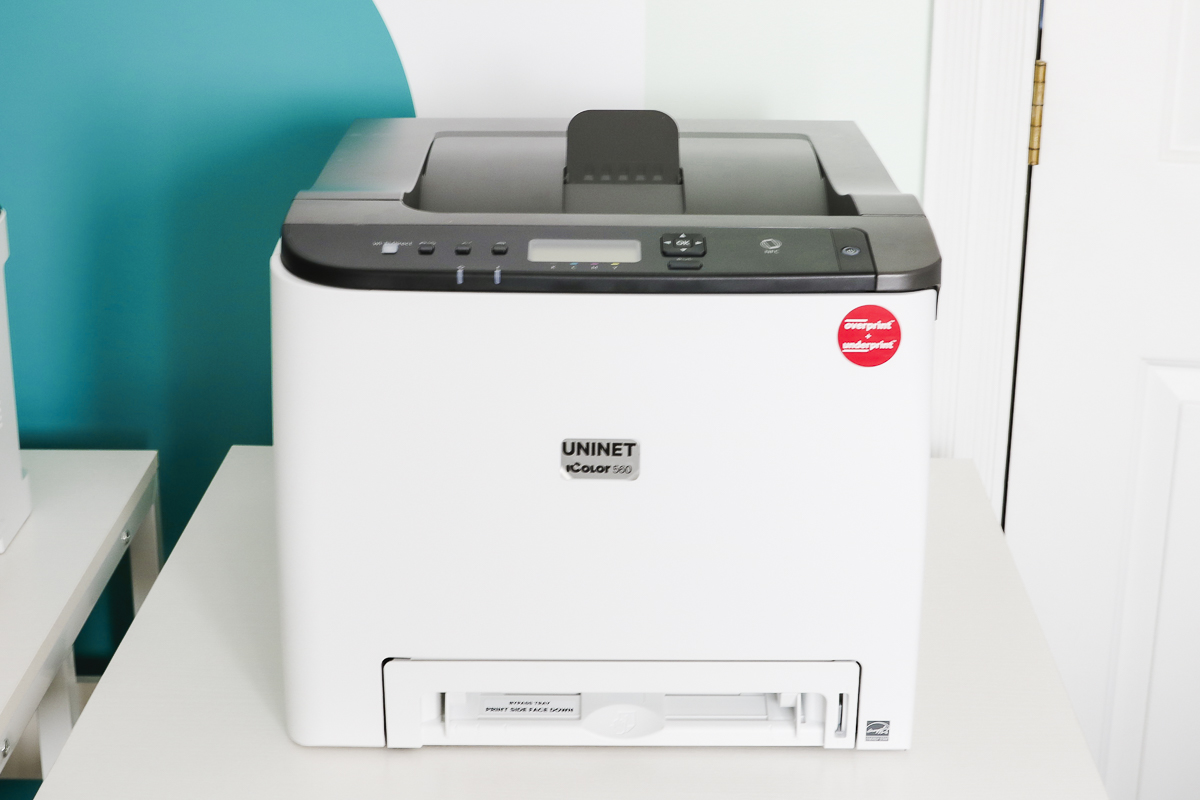
From hard to soft surfaces, you can make so many projects with a white toner printer.
- T-shirts
- Coasters
- Aprons
- Mugs
- Tumblers
- Garden Flags
- Banners
- Paper Crafts
- Packing Cubes
- Zipper Pouches
- Mylar Balloons
- Many, many others!
Who Needs a White Toner Printer?
White Toner printers are expensive, so I think they are still best for people who will regularly use them, especially small business owners.
Where DTF printers require regular use and a lot of maintenance, white toner printers do not. Because it is a toner printer, you can use it as little or as often as you want.
DTF prints are very easy to press once the adhesive is applied. White toner prints require a little more work. After printing on the film, you have to marry the print to the adhesive sheet, and then the pressing process is a little more involved.
You need a heat press that can apply heavy, consistent pressure. You cannot do this process with an EasyPress or Autopress.
There is also the option to convert a printer using the Absolute White toner cartridge. I have a full post about that as well.
Anytime I mention the word conversion know there are going to be some drawbacks, and they will involve a hack of some sort.
I think white toner printers are a great craft printer for someone who wants to make full color crafts and may not use them every day.
UV DTF Printers
UV DTF is very different from regular DTF. You need a different printer for each DTF printing process. Where DTF prints can be added to soft, porous surfaces, UV DTF prints are for hard surfaces.
Different Types of UV DTF Printers
There are a lot of UV DTF printers on the market. When I was at Printing United last year, everyone had a UV DTF printer, and they all looked really good, but as I was looking at them, I could see that there were differences, so make sure and do your research before purchasing.
Again, I would go through a reputable seller to ensure you have the support you need if any issues come up.
Next, I'll talk about the UV printer I recently tested. It does have an additional accessory you can purchase that will allow you to make UV DTF stickers.
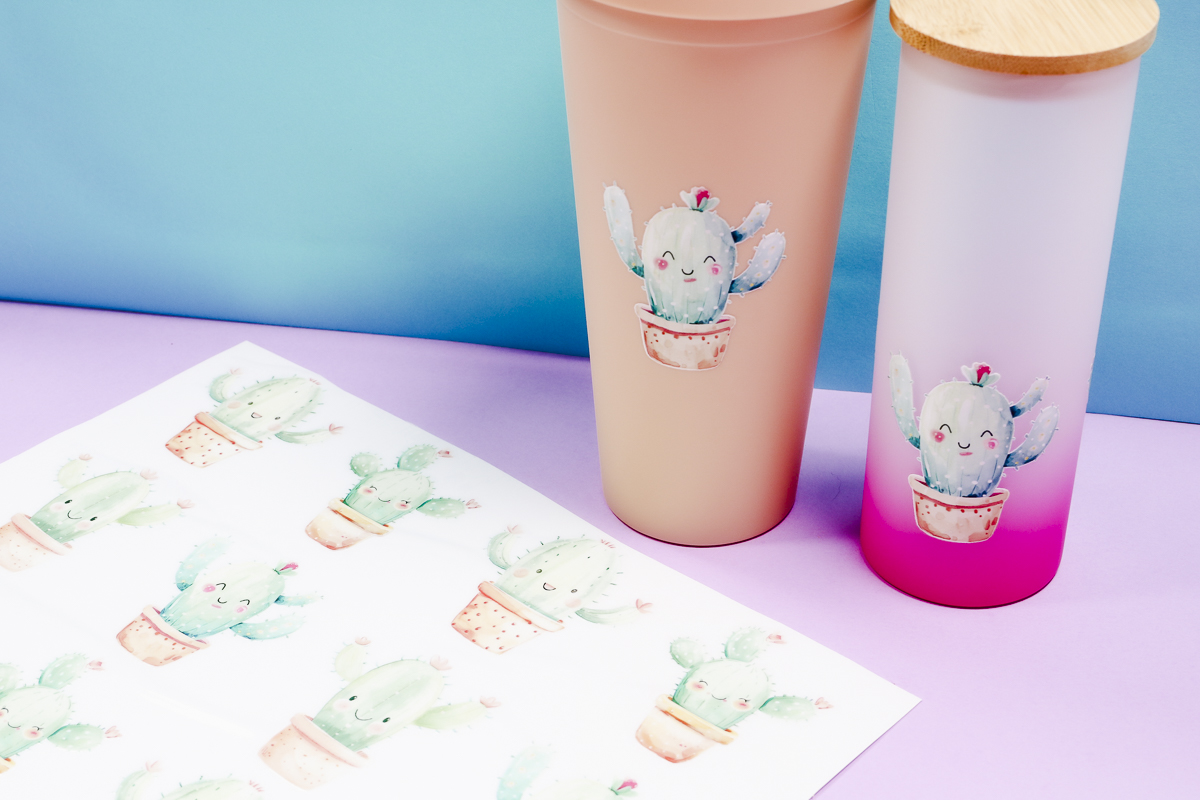
What Projects Can You Make with a UV DTF Printer?
UV DTF prints can be applied to hard surfaces. Think of the stickiest, longest-lasting sticker ever, and that is what a UV DTF print is.
These stickers can be added to almost any hard surface:
- Water Bottles
- Mugs
- Notebooks/Journals
- Keychains
- Bookmarks
- Cups/Glasses
You do need to be aware that when I say these are the stickiest stickers you've ever used, I am not exaggerating.
You need to be very careful when locating the sticker because you will not be able to lift it up and relocate it once it sticks down.
Who Needs a UV DTF Printer?
UV DTF printers require a lot of maintenance, like DTF printers do. You'll need to print regularly and make sure you're doing the required maintenance.
If you're a small business owner who wants to create permanent, professional stickers or finished projects made with these stickers, you'll want a UV DTF printer.
If you want amazing stickers for personal use or gifts, I recommend ordering those prints. They're easy to apply as you get the hang of it, and you don't have the expense or upkeep of owning a printer.
UV Printer
I recently got a new craft printer called the eufyMake UV printer. This printer prints directly on a lot of different surfaces, including wood, magnets, coasters, pens, and more.
Depending on the additional accessories you purchase, you can print on mugs and tumblers, and you can also print directly on film to create UV DTF stickers.
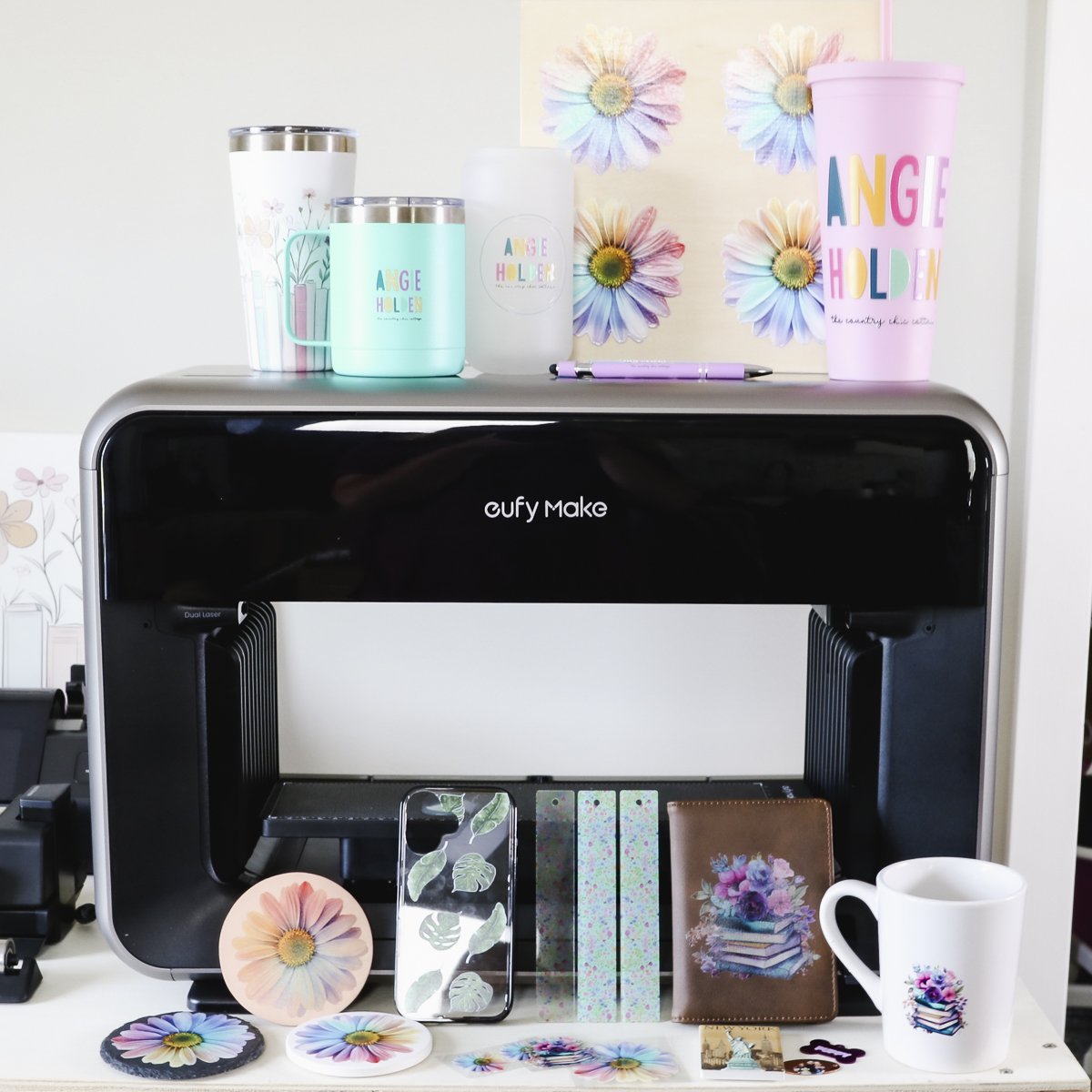
What Projects Can You Make with a UV Printer
I only have experience with the eufyMake UV printer as it is the first personal UV printer on the market.
The projects you can make will depend on the accessories you purchase to go with the eufyMake.
With the eufyMake itself, the projects will be a little smaller, but you can make projects like magnets, pens, pencils, coasters, anything that will fit on the bed that comes with the printer.
You can also purchase a larger bed, and that opens the door to bigger projects. I was able to create a larger wall hanging out of a canvas, and it turned out amazing.
If you purchase the rotary attachment, you can create mugs and tumblers with and without handles.
With the laminator accessory, you can create the UV DTF stickers that can be added to a wide variety of blanks.
Who Needs a UV Printer
The eufyMake personal UV printer is a great printer for any crafter. It does its own maintenance and is a great price point for small business owners and crafters who like to try different projects.
Because this printer has a small footprint, it's even great for crafters who don't have a lot of space.
I would recommend this printer to any crafter who is looking for these printing options.
Direct to Garment Printers
The last type of craft printer we're going to talk about today is a DTG printer. DTG stands for direct-to-garment.
These printers allow you to print directly on shirts and other fabrics.
These printers are very large and very expensive. There are some newer models coming out that are getting smaller and lower in price.
I feel like this technology will continue to evolve in the upcoming years, and we'll see more models aimed at personal crafters and small business owners.
There are restrictions like pretreating the blanks, but being able to print directly on shirts can offer a lot of crafting benefits.
Which Craft Printer is Right for You?
The craft printer or printers that are right for you will depend on the type of crafts you want to make.
If you want to print out stickers to use in scrapbooking, or want to create other Print Then Cut projects like labels, boxes, tags, etc, with your cutting machine, a home printer may be all you need.
Do you want to try something new, like adding full color designs on light colored clothing or other blanks? If that is the next step for you, a sublimation printer is a great option.
I do recommend a dedicated sublimation printer vs converting a printer. You'll have fewer issues, and that will save you time.
Currently, my favorites are the Brother SP1 and the Epson F170. These are both dedicated sublimation printers, and I really like them.

In the past, I have recommended the Sawgrass printers. Unfortunately, due to some software issues, I no longer recommend them.
Moving into DTF and White Toner printers, you're looking at a much larger price tag. I recommend starting by ordering prints. This will allow you to really test the process and help you decide the right craft printer for you.
I love both of these printing options, and by ordering prints, you can really get a feel for the system that is right for your needs.
UV DTF, UV printers, and DTG printers are all very specific, and you'd need to want to create those exact projects to justify the purchase price of those printers.
To choose the right printer for you, really look at the projects you want to make, and that will help you decide where to start.
Want to make shirts and hard surface items? You're looking at sublimation or white toner. If you don't want to have the light color restriction or polyester fabrics, white toner is the best option.
If you want the freedom to add prints to any type of fabric in any color, DTF prints are what you're looking for. To make shirts even faster and better, you'll want to look into investing in a DTG printer.
For shirts and hard surfaces that don't require sublimation coating, you'll want to purchase a white toner printer.
If you're looking at only hard surface projects, either UV DTF or UV printers are the printers I would research.
Help Deciding Which Printer is Right for You
As you can see, the right printer for you depends on a lot of things, most specifically the projects you see yourself making. Budget is another factor you'll need to take into account.
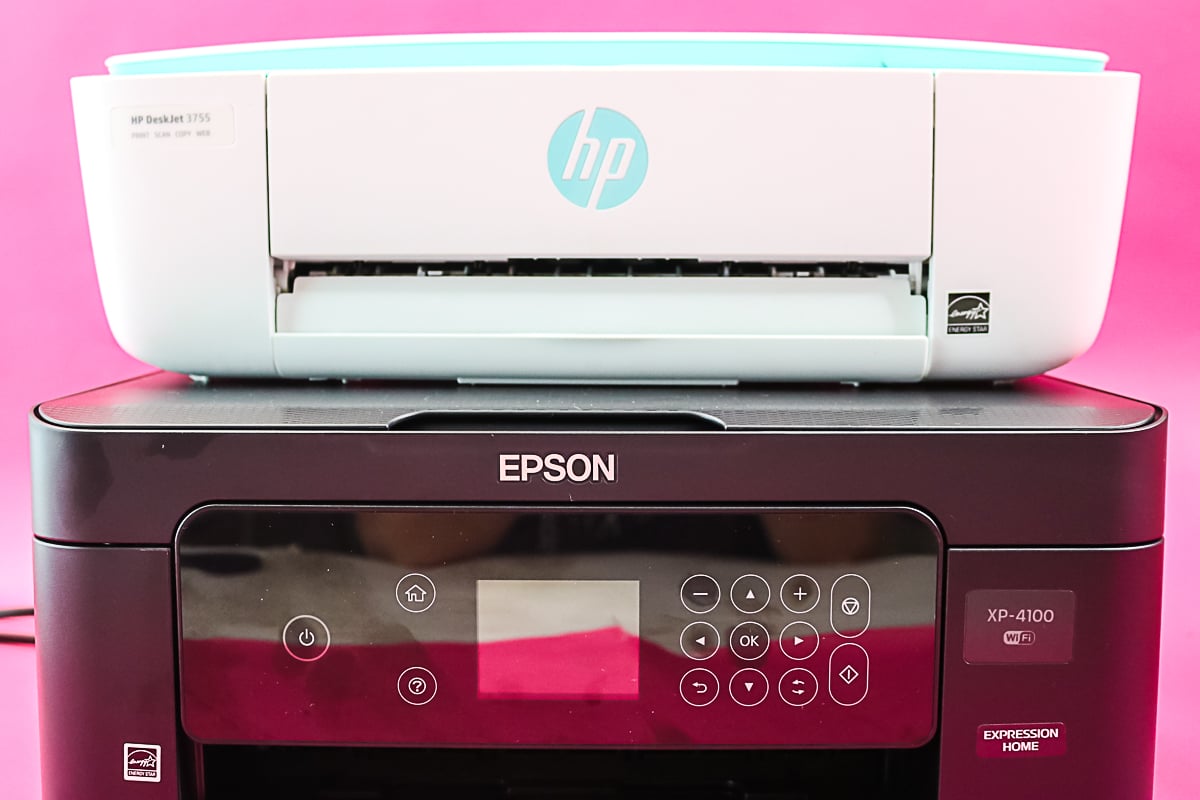
Regardless of what craft printer you're considering, please make sure you do your research.
Any printer you have to convert is no longer going to have a warranty. If you're worried about keeping your printer running for your small business, I would not suggest converting a printer.
At this point, there are a lot of printers on the market, and you want to make sure that you aren't wasting your money.
Read reviews and ratings, ask for recommendations, ask questions, and make sure the product you're purchasing can do everything you want it to do.
For the more expensive printers, I definitely recommend purchasing through a reputable dealer. You want to make sure you have good customer service to rely on and that there is a warranty in place.
I would also recommend double-checking the size restrictions for any printer you're considering. There's nothing worse than spending a lot of money only to find out you can't make the projects you want to make.
I hope I've answered any questions you have about craft printers. If you have additional questions, leave them in the comments, and I'll be happy to answer them for you.
